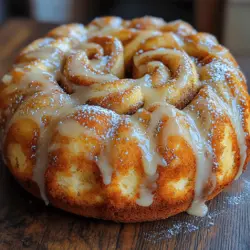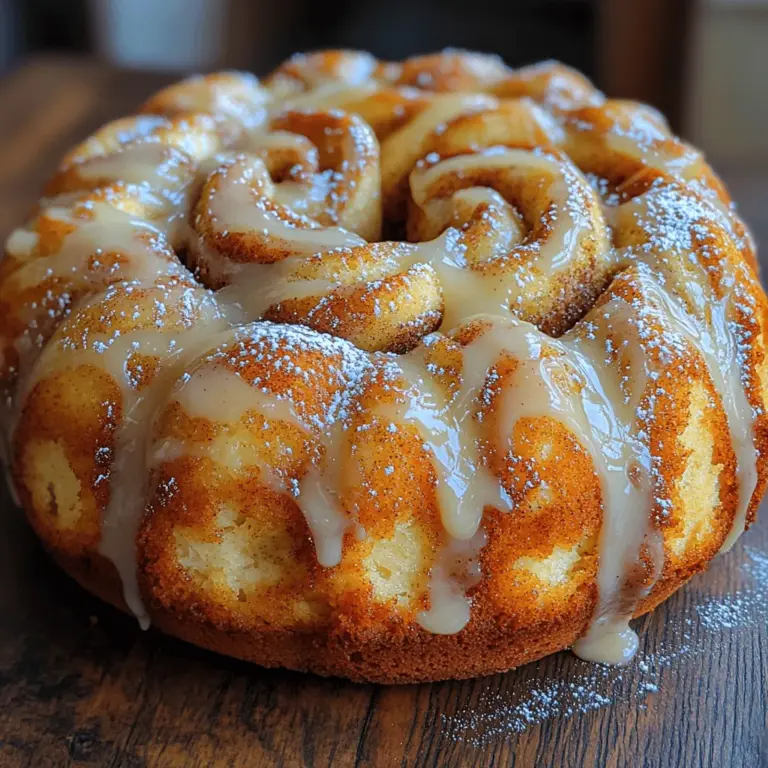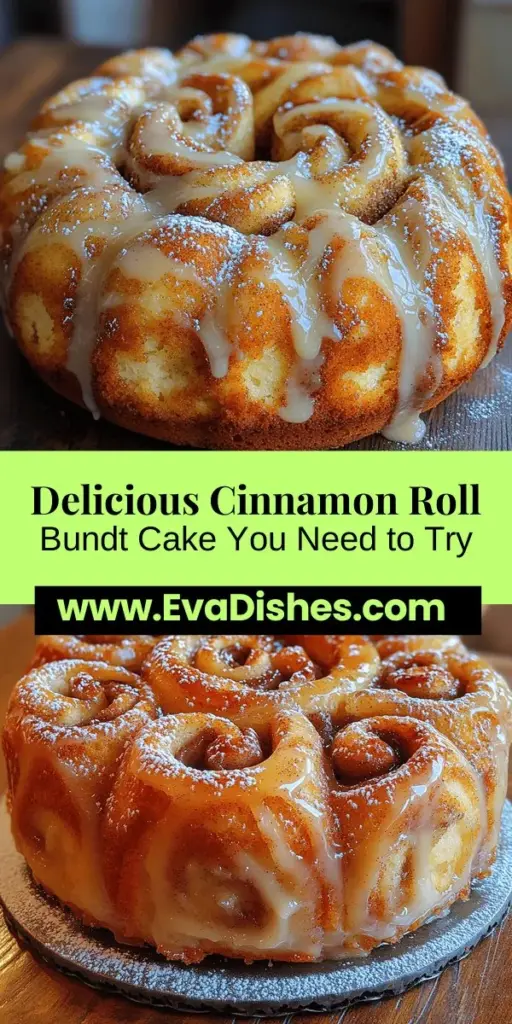Introduction
Cinnamon rolls have long been a cherished breakfast treat, known for their soft, pillowy texture and the intoxicating aroma of warm cinnamon wafting through the kitchen. Meanwhile, bundt cakes—a delightful twist on traditional cake—offer a visually stunning presentation and a moist crumb that makes them a favorite for any occasion. Imagine the best of both worlds: a cake that captures the cozy essence of cinnamon rolls while providing the ease and elegance of a bundt cake. Enter the Cinnamon Roll Bundt Cake, a delectable fusion that has quickly become a favorite among bakers and dessert lovers alike.
This Cinnamon Roll Bundt Cake is not just a feast for the eyes; it’s equally versatile, making it suitable for various occasions. Whether you’re hosting a brunch, looking for a sweet breakfast option, or craving a comforting dessert to share with friends and family, this cake fits the bill perfectly. The blend of warm cinnamon, rich butter, and a luscious cream cheese glaze creates an irresistible experience that is sure to delight everyone at the table.
In this article, we will guide you through the process of making this delicious cake, starting with an understanding of the key ingredients that make it so special, followed by a detailed step-by-step preparation guide. Let’s dive into the world of flavors and textures that come together in this show-stopping Cinnamon Roll Bundt Cake.
Understanding the Ingredients
To create the perfect Cinnamon Roll Bundt Cake, it’s essential to understand the role of each ingredient and how they contribute to the overall flavor, texture, and structure of the cake. Here’s a closer look at the key components that make this recipe shine:
All-Purpose Flour
All-purpose flour serves as the backbone of any cake recipe. In this Cinnamon Roll Bundt Cake, it is crucial for creating the structure and stability necessary to support the cake’s delightful layers. The protein content in all-purpose flour helps develop gluten, which gives the cake its desirable texture. For optimal results, be sure to measure the flour correctly—spoon it into the measuring cup and level it off to avoid a dense cake.
Baking Powder and Baking Soda
Both baking powder and baking soda play a vital role in leavening the cake, making it rise and creating that fluffy interior we all love. Baking powder is a double-acting leavening agent that releases carbon dioxide when it comes into contact with liquid and when it is heated. This helps the cake rise as it bakes. Baking soda, on the other hand, needs an acid to activate it, which in this recipe is provided by the buttermilk. Together, these two ingredients ensure that your cake has a light, airy texture.
Unsalted Butter
Unsalted butter is essential for adding flavor and moisture to the cake. It creates a rich, buttery taste that complements the warm spices of cinnamon beautifully. When creaming the butter with sugar, it’s important to use room temperature butter, as it will incorporate more air into the batter, resulting in a lighter cake. The fat content in butter also contributes to the overall tenderness of the cake, making it a key ingredient in achieving that perfect crumb.
Eggs
Eggs serve multiple purposes in this recipe. They act as a binding agent, helping to hold all the ingredients together while also adding richness and moisture to the cake. The proteins in eggs provide structure, while the fat in the yolks contributes to a tender crumb. For best results, use large eggs at room temperature, as they will mix more easily into the batter and help create an even consistency.
Buttermilk
Buttermilk is another critical ingredient that impacts the texture and flavor of the cake. Its acidity helps to tenderize the gluten in the flour, resulting in a softer crumb. Additionally, buttermilk adds a subtle tang that balances the sweetness of the cake, enhancing the overall flavor profile. If you don’t have buttermilk on hand, you can easily make a substitute by mixing milk with a splash of vinegar or lemon juice and letting it sit for a few minutes before using.
Exploring the Cinnamon Swirl
The cinnamon swirl is where the magic happens in this Cinnamon Roll Bundt Cake. It’s what transforms a simple cake into a flavorful masterpiece. The combination of brown sugar and ground cinnamon creates a sweet, aromatic filling that runs through the cake, reminiscent of classic cinnamon rolls.
Brown Sugar vs. Granulated Sugar
In this recipe, brown sugar is preferred for the cinnamon filling because of its higher moisture content and caramel-like flavor. Brown sugar contains molasses, which adds depth and complexity to the sweetness, making it an ideal choice for the cinnamon swirl. Granulated sugar, while it can be used, will not provide the same rich flavor or moisture and may lead to a slightly drier texture.
Ground Cinnamon
Ground cinnamon is the star of this recipe. Not only does it provide that signature warm and comforting flavor, but it also brings along several health benefits, such as anti-inflammatory properties and antioxidants. The aromatic spice enhances the cake, making each bite a delightful experience. When measuring cinnamon, it’s best to use fresh ground cinnamon for the most potent flavor.
Cream Cheese Glaze
To finish off this beautiful bundt cake, a cream cheese glaze is an absolute must. The glaze adds a creamy, tangy sweetness that complements the warm spices and rich flavors of the cake. Made with cream cheese, powdered sugar, and a splash of vanilla extract, this glaze is easy to prepare and elevates the visual appeal of the cake. The smooth consistency of the glaze drizzled over the cake creates an enticing finish that draws everyone in.
Step-by-Step Preparation Guide
Now that we’ve explored the ingredients that make this Cinnamon Roll Bundt Cake so irresistible, it’s time to get into the nitty-gritty of the preparation process. Follow these detailed steps to ensure your cake turns out perfectly every time:
Prepping Your Bundt Pan
Before you even begin mixing the ingredients, it’s essential to prepare your bundt pan properly. A well-greased and floured pan will help prevent the cake from sticking and ensure a smooth release once it’s baked.
1. Greasing: Use unsalted butter or a non-stick baking spray to generously grease the interior of the bundt pan. Make sure to get into all the crevices and corners to avoid any sticking.
2. Flouring: After greasing, sprinkle a light layer of all-purpose flour into the pan. Tilt and turn the pan to coat the greased surface evenly, then tap out any excess flour. This creates a protective barrier between the cake and the pan, allowing for easy removal.
Mixing Dry Ingredients
With your bundt pan ready, it’s time to tackle the dry ingredients. This step is crucial for achieving a consistent batter.
1. In a medium bowl, whisk together the all-purpose flour, baking powder, baking soda, and ground cinnamon until well combined.
2. Whisking helps to evenly distribute the leavening agents and the cinnamon throughout the flour, ensuring that your cake rises uniformly. Set aside the dry mixture while you prepare the wet ingredients.
Creaming Butter and Sugar
Creaming the butter and sugar is a pivotal step in cake baking, as it incorporates air into the batter, resulting in a light and fluffy cake.
1. In a large mixing bowl, use an electric mixer to cream together the unsalted butter and brown sugar until the mixture is light and fluffy. This will take about 3-5 minutes on medium speed.
2. Scrape down the sides of the bowl as needed to ensure even mixing. The goal is to achieve a pale color and a smooth texture, indicating that you’ve successfully incorporated air into the mixture.
Incorporating Eggs and Vanilla
Next, it’s time to add the eggs and vanilla extract, which will enrich the cake’s flavor and texture.
1. Add the eggs, one at a time, mixing well after each addition. This gradual incorporation helps prevent curdling and ensures a smooth batter.
2. Once all the eggs are added, pour in the vanilla extract and mix until combined. The aroma of vanilla will enhance the overall flavor of the cake, providing a delightful backdrop for the cinnamon and sugar.
As you prepare to combine the wet and dry ingredients, stay tuned for the next steps in this exciting baking journey that will take you from a simple batter to a magnificent Cinnamon Roll Bundt Cake.
Combining Wet and Dry Ingredients: Achieving a Smooth Batter
To create the perfect Cinnamon Roll Bundt Cake, it’s essential to combine your wet and dry ingredients correctly. Start by preparing your dry mix, which typically consists of all-purpose flour, baking powder, baking soda, salt, and ground cinnamon. In a separate bowl, whisk together your wet ingredients, including granulated sugar, eggs, vanilla extract, and melted butter or vegetable oil.
When you’re ready to combine, pour the wet ingredients into the bowl of dry ingredients. Use a spatula or a wooden spoon to gently fold the mixture together. Be careful not to over-mix; the goal is to combine everything until you no longer see dry flour. A few lumps are perfectly fine; they will disappear during baking. Over-mixing can lead to a dense cake, so embrace the lumps for that perfect, fluffy texture.
Creating the Cinnamon Swirl: Techniques for Perfect Marbling
The signature feature of your Cinnamon Roll Bundt Cake is, of course, the delightful cinnamon swirl. To achieve this, you’ll need a mixture of ground cinnamon and brown sugar, which creates a sweet, sticky filling.
Once your batter is ready, pour a portion of it into the greased Bundt pan, and then sprinkle a generous layer of the cinnamon-sugar mixture on top. Next, add another layer of batter over the cinnamon-sugar filling, followed by another sprinkling of the cinnamon-sugar mixture.
For the perfect marbling effect, take a knife or a skewer and gently swirl through the batter. Aim for a figure-eight motion to create an even distribution of cinnamon throughout the cake. Be careful not to overdo it; you want a beautiful marble effect, not a completely mixed batter.
Layering the Batter: Best Practices for Even Distribution and Swirling
Layering the batter effectively ensures that the cinnamon swirl is evenly distributed throughout the cake, providing a consistent flavor in every bite. Begin by pouring about one-third of your batter into the prepared Bundt pan, ensuring it covers the bottom evenly.
Next, sprinkle half of the cinnamon-sugar mixture over this layer. Add another third of the batter on top of the sugar, and repeat the process with the remaining sugar and batter. Finish with the final third of the batter, smoothing the top lightly to ensure an even surface.
As you swirl the cinnamon-sugar mixture into the layers, be mindful to not disrupt the bottom layer too much. This attention to detail will ensure that when the cake is baked, each slice reveals a beautiful swirl of cinnamon, reminiscent of classic cinnamon rolls.
Baking the Cake
Ideal Baking Conditions: Recommended Oven Settings and Placement
Preheat your oven to 350°F (175°C) before you start baking. This temperature is crucial for achieving that golden brown crust while keeping the interior moist. Once your batter is layered and swirled, place the Bundt pan on the center rack of the oven. Positioning it in the center allows for even heat circulation, which is essential for a well-baked cake.
Timing: How to Check for Doneness and Avoid Overbaking
Baking time for your Cinnamon Roll Bundt Cake typically ranges from 45 to 55 minutes. However, oven temperatures can vary, so it’s important to start checking for doneness around the 45-minute mark. Insert a toothpick into the thickest part of the cake; if it comes out clean or with a few moist crumbs, your cake is ready.
Avoid opening the oven door too frequently, as this can cause the cake to sink. Once you determine it’s done, remove it from the oven and allow it to cool in the pan for about 10 to 15 minutes before inverting it onto a wire rack.
Cooling Process: Why It’s Crucial to Let the Cake Cool in the Pan
Cooling the cake in the pan is a critical step that shouldn’t be overlooked. Allowing it to sit for a few minutes helps the cake firm up and reduces the risk of it breaking apart when you flip it out onto the wire rack.
After the initial cooling period, gently run a knife around the edges of the pan to loosen any areas that may have stuck. Carefully invert the Bundt pan onto the wire rack, and give it a gentle tap to release the cake. Let it cool completely before glazing to ensure the icing doesn’t melt off.
Preparing the Cream Cheese Glaze
Importance of Room Temperature Ingredients for a Smooth Glaze
For the cream cheese glaze to achieve that velvety smooth consistency, it’s vital that your cream cheese and butter are at room temperature. Cold ingredients can lead to lumps, which will not only affect the appearance of your glaze but also its texture.
Step-by-Step Instructions for Achieving the Perfect Consistency
To prepare your cream cheese glaze, start by beating together the room temperature cream cheese and unsalted butter until the mixture is creamy and smooth. Gradually add powdered sugar, mixing until well incorporated. Then, drizzle in vanilla extract and a splash of milk to achieve the desired consistency. If your glaze is too thick, add more milk a teaspoon at a time until it reaches a pourable state.
Variations in Flavors: Suggestions for Enhancing the Glaze
While the classic cream cheese glaze is delicious on its own, consider enhancing it with various flavors. Adding a teaspoon of lemon or orange zest can brighten the flavor profile, giving it a hint of citrus that pairs beautifully with cinnamon. Alternatively, a splash of maple syrup can add a warm, earthy tone to your glaze.
Serving Suggestions
Presentation Ideas for the Cinnamon Roll Bundt Cake
Once your cake is fully cooled and glazed, it’s time to present it. A simple yet elegant way to serve your Cinnamon Roll Bundt Cake is to dust the top lightly with additional powdered sugar or ground cinnamon for a visually appealing finish. You can also garnish with a few pecans or walnuts for added texture.
Pairing Recommendations
This cake pairs wonderfully with a variety of beverages. A hot cup of freshly brewed coffee complements the cake’s sweetness, while a robust black tea can balance the flavors. For a more indulgent experience, serve it with a glass of cold milk, which moistens each bite and enhances the overall enjoyment.
Creative Serving Options: Slicing Techniques and Plating Ideas
When it comes to slicing the cake, ensure your knife is sharp to achieve clean cuts. For an impressive presentation, you can slice the cake into wedges and arrange them on a decorative platter. Consider drizzling extra glaze over the slices or serving them alongside a scoop of vanilla ice cream for a delightful dessert experience.
Nutritional Information
Overview of the Nutritional Content of the Cake Per Serving
Understanding the nutritional content of your Cinnamon Roll Bundt Cake can help you enjoy it mindfully. On average, a single slice (about 1/12 of the cake) contains approximately 300 calories, with 15 grams of fat, 40 grams of carbohydrates, and 3 grams of protein.
Discussion on Portion Control and Indulgence
While this cake is undeniably a treat, practicing portion control is essential for maintaining a balanced diet. Consider cutting smaller slices if serving at a gathering to allow guests to sample without overindulging. This way, everyone can enjoy a piece while savoring the delightful flavors of your homemade creation.
Conclusion
The experience of making and enjoying a Cinnamon Roll Bundt Cake is nothing short of delightful. This cake, with its warm cinnamon aroma and rich cream cheese glaze, serves as a perfect centerpiece for gatherings or a comforting indulgence for personal enjoyment. Whether it’s a family brunch, a holiday celebration, or simply a cozy afternoon treat, this recipe is sure to impress.
Embrace the joy of baking, experiment with flavors, and share your own experiences with friends and family. The satisfaction of creating this delicious cake from scratch is an experience worth savoring, and we encourage you to take the plunge and enjoy every moment in the kitchen.



